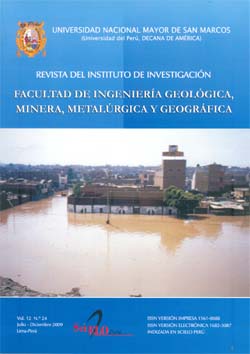Behavior of the Leached Metal Ions in Copper Cementation
DOI:
https://doi.org/10.15381/iigeo.v12i24.352Keywords:
Copper cements, cementation, leaching-cementation, kinetics of cementationAbstract
This article describes the cementation process of leached solutions from copper sulphide ores being and without being toasted. With favorable results in this study, we get the pattern for the feasibility of moving from the classical technology of concentration to the technology of cementation of copper sulfide minerals containing silver and gold. Simulation steps have been performed considering the different variables involved in the process such as time, agitation, solution concentration, pH and others. A kinetic model of copper cementation from PLS solutions purified by Solvent Extraction (SX) has been developed and it has the following form: C = 6.08 exp (- 0.03 t) Recoveries were obtained greater than 90% copper, which gives the possibility to improve the costs of national ores and con- centrates, as well as to open a favorable scenario for new national metallurgical projects.Downloads
Published
Issue
Section
License
Copyright (c) 2009 Daniel Lovera, Angel Bustamante, Janet Quiñones, Vladimir Arias, Luis Puente, Meylin Terrel, Ronald Valencia, Ricardo Soto, Rosa Coronado, Diego Carvajal, Lia Concepción, Anselmo Sánchez, Jasmin Sánchez

This work is licensed under a Creative Commons Attribution-NonCommercial-ShareAlike 4.0 International License.
AUTHORS RETAIN THEIR RIGHTS:
a. Authors retain their trade mark rights and patent, and also on any process or procedure described in the article.
b. Authors retain their right to share, copy, distribute, perform and publicly communicate their article (eg, to place their article in an institutional repository or publish it in a book), with an acknowledgment of its initial publication in the Rev. Inst. investig. Fac. minas metal cienc. geogr.
c. Authors retain theirs right to make a subsequent publication of their work, to use the article or any part thereof (eg a compilation of his papers, lecture notes, thesis, or a book), always indicating the source of publication (the originator of the work, journal, volume, number and date).






